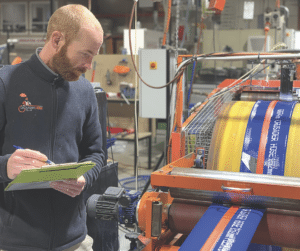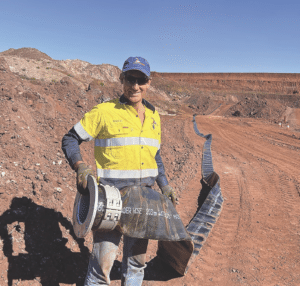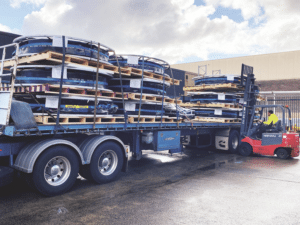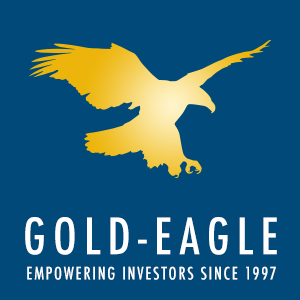Australian Mining spoke with Crusader Hose managing director Francois Steverlynck about how the company is embracing ESG.
For almost 40 years, Crusader Hose has been a leader in layflat hose and reel system manufacturing.
Based in Bayswater, Victoria, the company designs dewatering systems for safer handling up high pit walls, resulting in greater time and cost efficiencies.
“Our products have ease of use and complement existing systems,” Crusader Hose managing director Francois Steverlynck told Australian Mining.
“Requiring minimal set-up, our layflat hose system can be easily redeployed following its initial use, whether the system is reused on the same mine site or at another mine in a different part of the country.
“We strive to design, engineer and manufacture innovative solutions that drive profitability and are tailored to the unique needs of our customers.”

Image: Crusader Hose
The reusability and mobility of Crusader Hose’s products is what sets them apart from typical rigid pipe solutions. This in turns drives improved environmental outcomes.
“Many pipes in the industry are made from single use plastic,” Steverlynck said.
“And because of the weight and size of many competitor pipes, more trucks and infrastructure are required to transport them to site and when rehabilitating site, driving a higher carbon footprint.
“Our layflat hose system is a more compact option, requiring only 10 per cent of the vehicles required to transport competitor pipes.”
The layflat hose system is easy to install, an attribute embodied by Crusader Hose’s Waterlord layflat hose system.
One end of a rope connects to the Waterlord layflat hose at the top of a mine pit. The tail end is then connected to a vehicle at the bottom of the pit.
As the vehicle moves forward, the flat and flexible Waterlord hose is dragged safely down the slope, following the contours of the terrain and supporting itself. This means it won’t slide down and no anchoring is required.
The Waterlord hose is also UV resistant, has high-pressure capability for deep mining pits and is abrasion resistant against mixed terrain, making it the perfect hose for tough mining conditions. There is no derating in extreme heat, meaning pipes don’t pull apart, even at 70°C.
Retrieving water has also been made easier through Crusader Hose’s Flexibore 250 hose, which has been designed to carry out deep groundwater pumping up to 250m.

Image: Crusader Hose
The hose can dilate up to 15 per cent, optimising efficiency in reducing pumping costs and friction loss. By dilating under pressure, there is no build-up of iron bacteria, as seen with rigid pipe offerings such as polypipe or fibreglass.
Like the Waterlord hose, the Flexibore 250 is easy to install and is made of high-tensile polyester, giving the hose a high burst pressure for deep bore pumping.
The Flexibore is available in 100m, 150m, 300m and 400m lengths, meaning miners have several options to make their dewatering and water pumping processes easier.
While the process of manufacturing a layflat hose is inherently environmentally friendly, as Crusader Hose looks to take its solutions to the next level, the company is accelerating its ESG (environmental, social and governance) strategy.
“We take ESG into account in everything we do,” Steverlynck said. “But while we’ve always been an environmentally responsible company, we must be even more proactive these days.
“We have built our layflat hoses to be durable and reusable, while we have also taken it upon ourselves to eliminate the use of solvents from our manufacturing process, as we learnt about the potential damage solvent emissions can have on the environment,” Steverlynck said.
Crusader Hose’s mission to remove solvents saw the company explore a number of different manufacturing methods, enabling the continued evolution of its quality layflat hose.
While achieving greater environmental outcomes is a key part of ESG, Crusader Hose also understands its social role. As an Australian manufacturer, the company aids the local economy by creating local jobs and opportunities.
“According to some of our military clients, $1 million spent with a local company has the potential to bring in 10 times that amount for the local industry,” Steverlynck said.
“And it’s not just about local recruitment; we also encourage training and education among our workforce so they can gain higher level skills and move into new roles, which leads to smarter manufacturing and a better layflat hose.”

Image: Crusader Hose
On a governance level, Crusader Hose provides leadership opportunities for its staff. The company’s management team also holds regular meetings, both weekly and monthly, to discuss the organisation in a transparent manner.
“We are able to keep each other in check and stay accountable through our board,” Steverlynck said.
Founded in 1985, Crusader Hose has grown its business to over 60 employees. This has seen the company’s Bayswater footprint expand to seven factories.
Crusader Hose’s expansion has not only been driven by the growing uptake of its layflat hose solutions, but also by the company’s increased ESG focus.
“We haven’t sought recognition, we are just trying to be an employer of choice,” Steverlynck said. “Looking ahead, we want to further reduce our plastic waste to landfill.
“Plastics are biodegradable, but that process takes hundreds of years. Therefore, we’re looking to carry out operational excellence by creating products that don’t have faulty bits and pieces. Because if you get a faulty product, you toss it into landfill and add more waste.”
Steverlynck has been focused on increasing gender balance over time. The company is also committed to continue holding open days so people can see Crusader Hose’s proud role within the community.
“It all ties into who we are and how we operate,” Steverlynck said.
This feature appeared in the June 2024 issue of Australian Mining.




